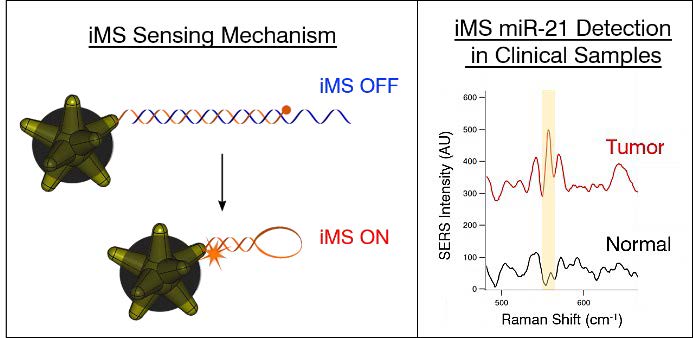创新背景
MicroRNAs是一种短RNA分子,它与信使RNA结合,阻止信使RNA向身体的蛋白质生产机器传递指令。这可以有效地抑制DNA的某些部分或调节基因表达,从而改变某些生物功能的行为。在人类中已经发现了2000多个影响发育、分化、生长和代谢的microRNAs。
随着研究人员对这些微小基因包的发现和了解越来越多,许多microrna与生物功能的失调有关,从而导致从脑瘤到阿尔茨海默症等多种疾病。这些发现使得人们对使用microRNAs作为疾病生物标志物和治疗靶点越来越感兴趣。由于人体样本中mirna的含量非常少,传统的研究方法需要基因扩增过程,如定量反转录PCR (qRT-PCR)和RNA测序。
创新过程
该实验室的一般研究重点一直是在人们知道自己生病之前对他们的疾病进行早期检测,要做到这一点,则需要能够在基因组水平上向上游发展,观察像microRNA这样的生物标志物。
虽然这种技术在设备完善的实验室和可能需要数月或数年时间的研究中表现出色,但它们并不适合在临床或野外获得快速诊断结果。为了弥补这一差距,voo - dinh和他的同事们正在转向镀银金纳米星。
金纳米星有多个尖刺,可以作为增强电磁波的照明棒,这是粒子形状的一个独特特征,新型微型纳米传感器,被称为‘逆向分子哨兵’,利用这种能力创造出多个微型RNA存在着清晰信号。

用于创建新型癌症诊断的少数纳米星的特写视图
纳米传感器设计的基本思想是,当识别并捕获特定的目标RNA片段时,让标记分子非常靠近恒星的尖刺。当激光照射到被触发的传感器上时,纳米星尖端的避雷针效应会使标记分子发出极其明亮的光,表明目标RNA已被捕获。
研究人员将一个标记分子与一段DNA连接在纳米星的一个点上,从而设置了这个触发器。尽管DNA本身是卷曲成一个环,但它是由一个RNA“间隔器”保持开放的,该“间隔器”专门与被测试的目标microRNA结合。当那个microRNA经过时,它会粘在间隔物上并将其去除,使DNA自身卷曲成一个环,使标记分子与纳米星紧密接触。
在激光激发下,标签发出一种叫做拉曼信号的光,这种信号通常非常微弱。但是纳米星的形状——由金纳米星和银涂层引起的独立反应的耦合效应——将拉曼信号放大了数百万倍,使它们更容易被探测到。
标签分子的拉曼信号显示出具有非常特殊颜色的尖峰,就像光谱指纹,这使它们在被检测到时很容易被区分开来,因此,研究人员可以为纳米星上的不同microRNAs设计不同的传感器,每个传感器都有标签分子,显示出自己特定的光谱指纹。由于信号非常强,就可以独立地检测到每一个指纹。

在新的诊断方案中,标签分子(橙色球体)通过RNA垫片(蓝色)与纳米恒星保持距离。当匹配的RNA序列存在时,它会剥离间隔物,导致DNA系绳(橙色)卷曲,使标记分子靠近纳米星。右图显示了由产生的放大光发射引起的信号尖峰。
在这项临床研究中,Vo-Dinh和他的团队与医学副教授Katherine Garman以及杜克癌症研究所的同事合作,使用新的纳米传感器平台来证明他们可以检测miR-21,一种与食道癌早期阶段相关的特定的microRNA,就像其他更复杂的最先进的方法一样。在这种情况下,单独使用miR-21就足以区分健康组织样本和癌变组织样本。然而,对于其他疾病,可能需要检测其他几种microrna来获得可靠的诊断,这正是为什么研究人员对他们的反分子哨兵纳米生物传感器的普遍适用性如此兴奋的原因。
创新关键点
金纳米星有多个尖刺,可以作为增强电磁波的照明棒,这是粒子形状的一个独特特征,新型微型纳米传感器,被称为“逆向分子哨兵”,利用这种能力创造出多个微型RNA存在着清晰信号。
研究人员将一个标记分子与一段DNA连接在纳米星的一个点上,从而设置了这个触发器。尽管DNA本身是卷曲成一个环,但它是由一个RNA“间隔器”保持开放的,该“间隔器”专门与被测试的目标microRNA结合。当那个microRNA经过时,它会粘在间隔物上并将其去除,使DNA自身卷曲成一个环,使标记分子与纳米星紧密接触。
创新价值
通常三到四个遗传生物标记物可能足以得到一个好的诊断,这些类型的生物标记物可以准确地识别每种疾病。新方法可以提供一种替代组织病理学和PCR的诊断方法,从而简化癌症诊断的检测过程。
New optical sensing platform can directly detect early cancer biomarkers
The lab's general research focus has been on early detection of people's diseases before they know they're sick, and to do that requires being able to move upstream at the genomic level to look at biomarkers like micrornas.
While such techniques perform well in well-equipped laboratories and in studies that can take months or years, they are not well suited to obtain rapid diagnostic results in the clinic or in the field. To bridge this gap, Voo-Dinh and his colleagues are turning to silver-plated gold nanostars.
Gold nanostars have multiple spikes that act as lighting rods to enhance electromagnetic waves. This is a unique feature of the particle shape. New tiny nanosensors, known as' reverse molecular Sentinels', use this ability to create a clear signal of the presence of multiple tiny Rnas.
The basic idea behind nanosensor design is to keep the labeled molecule very close to the star's spike when a specific target RNA fragment is recognized and captured. When a laser shines on the triggered sensor, the lightning-rod effect at the tip of the nanostar causes the labeled molecule to glow extremely bright, indicating that the target RNA has been captured.
The researchers set the trigger by attaching a marker molecule to a piece of DNA at a spot on the nanostar. Although DNA itself is coiled into a loop, it is kept open by an RNA "spacer" that binds specifically to the target microRNA being tested. As that microRNA passes by, it sticks to the spacer and removes it, curling the DNA into a loop on its own, bringing the marker molecule into close contact with the nanostar.
When excited by a laser, the tag emits a light called a Raman signal, which is usually very weak. But the shape of the nanocar - a coupling effect of the independent reactions caused by the gold nanocar and the silver coating - amplifies the Raman signal by millions of times, making them easier to detect.
Label molecular Raman signal shows a very special color of spike, like spectral fingerprints, which makes them being detected is easy to distinguish, as a result, the researchers can be designed for different microRNAs nano star on different sensors, each sensor has a label, showing their specific spectral fingerprints. Because the signal is so strong, each fingerprint can be detected independently.
In this clinical study, Vo-Dinh and his team, in collaboration with Katherine Garman, associate professor of medicine, and colleagues at Duke Cancer Institute, used a new nanosensor platform to demonstrate that they could detect Mir-21, a specific microRNA associated with the early stages of esophageal cancer, Just like any other more sophisticated state-of-the-art method. In this case, Mir-21 alone was sufficient to distinguish healthy tissue samples from cancerous tissue samples. For other diseases, however, it may be necessary to test several other micrornas to obtain a reliable diagnosis, which is exactly why the researchers are so excited about the universal applicability of their anti-molecular sentry nanobiosensor.
智能推荐
OrganEx新技术维持已死亡个体的血液循环
2022-08-08美国耶鲁大学医学院的研究团队开发出了一种名为 OrgnEx 的系统,经实验表明,该系统可以让氧气在死亡的猪体内重新循环,减少细胞死亡并恢复整个身体的循环。这项研究可能有助于延长手术期间人体器官的健康,还可用于保存组织器官,增加移植器官的可用性。
涉及学科涉及领域研究方向生命科学创新 | 通过探究SMCHD1蛋白质的遗传过程创新孟德尔疾病的解释方式
2022-09-24研究从母亲的基因对后代的影响创新孟德尔疾病的解释方向,强调从母亲那里遗传的基因在儿童遗传疾病中的作用,提高了对此类疾病的理解。
涉及学科涉及领域研究方向衰老可能导致大脑突变率的提高
2022-08-15来自耶鲁大学、梅奥诊所和约翰霍普金斯医学院利伯大脑发育研究所的研究团队进行了对人类大脑体细胞突变的首次大规模研究,发现高龄人群大脑的突变率更高,而且这种高突变与疾病无关。此外,研究团队还发现了体细胞突变的相关机制。
涉及学科涉及领域研究方向生物研究者通过获取肿瘤特异性肽开发癌症治疗新技术
2022-09-01研究创造性地将胸腔积液用于确定HLA结合肽库的科学用途,从胸腔积液中获取肿瘤肽的能力或许可以为晚期癌症的治疗开辟新的途径。
涉及学科涉及领域研究方向